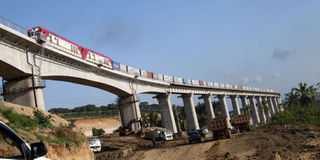Kenya earns Sh7.54bn from ferrying cargo on SGR

Kenya earned Sh7.54 billion in the nine months to September last year from the Standard Gauge Railway freight business. PHOTO | FILE
What you need to know:
- China Road and Bridge Corporation runs the SGR cargo and passenger services for an undisclosed management fee.
- February on the other hand was its lowest earning month, raking in Sh435.18 million.
Kenya earned Sh7.54 billion in the nine months to September last year from the Standard Gauge Railway (SGR) freight business. This was from the transportation of more than 3.25 million tonnes of cargo.
This comes as passenger numbers dropped by almost 200,000, an indication that the train’s restrictive schedule, stiff competition from bus companies and low-cost airlines could be eating into SGR’s share of travellers.
Latest data from the Kenya National Bureau of Statistics (KNBS), as provided by the Kenya Railways, shows SGR cargo earnings in the nine months almost doubled, compared to its 2018 earnings, which stood at Sh4.09 billion.
PROMOTIONAL TARRIFF
The income almost doubled in April last year, after Kenya Railways ended the promotional tariff and reverted to the charges it had agreed on with the Transport ministry and the Kenya Ports Authority.
China Road and Bridge Corporation runs the SGR cargo and passenger services for an undisclosed management fee.
The charges saw traders paying between Sh51,275 per 20-foot container and Sh70,000 for a 40-foot container, double the promotional tariff of Sh25,000 per 20-foot container and Sh35,000 for a 40-foot container.
This means the country is projected to earn over Sh10 billion in 2019 from the railway freight business, which is still below its annual operating cost of Sh18 billion.
IMPROVED FIGURES
August was the highest grossing month for the line, earning Kenya Railways and the Chinese concessionaire, China Communications Construction Company, Sh1.15 billion, from the 430,450 tonnes it moved. February on the other hand was its lowest earning month, raking in Sh435.18 million.
However, the improved figures are still below the target as the line maintains a standard number of trains leaving Mombasa for Nairobi, mostly due to limited storage capacity at the Embakasi Inland Container Depot (ICDN), the cost tariff and the low usage of the Nairobi Freight Terminal, which handles cargo that is not stored in containers.
The rise in cargo revenues also comes at a time civil society groups and business operators including cargo handlers have been staging protests — since August last year — over a government directive to have all cargo moved through the railway line.
The government has since rescinded the directive. The data also shows the number of passengers using the train has fallen from 1.38 million over a similar period in 2018 to 1.18 million last year, an interesting trend given that this was meant to decongest the Mombasa-Nairobi Highway.
The passenger line earned the country Sh1.28 billion in the nine months of last year, an increase from Sh1.12 billion over the same period in 2018.
August recorded the highest traffic at 165,971 passengers, raking in Sh120.7 million. In 2018, passengers paid Sh1.6 billion. The data also shows April and August remain the best performing months as Kenyans flock the Coast for the holidays.
In 2017, SGR, which had been in operation for only six months, moved close to 700,000 passengers, earning the country more than Sh627.6 million.
The increased earnings from both the passenger and cargo lines come at a time the country principal payments to Exim Bank of China, the main SGR financier, rose six fold to nearly Sh30.9 billion in the last financial year. The Treasury is expected to cough up Sh61.2 billion in the current financial year to service the loan.
With the earnings still below the railways operating costs, this means that treasury will have to look for the repayments costs elsewhere. In May 2014, Kenya entered into a financing deal for the railway with China’s Exim Bank in May 2014, advancing the former Sh323 billion, which comprised of Sh163 billion as a commercial loan and Sh160 billion as concessional loan. Nairobi used this funds to build the more than 400 km railway between Mombasa and Nairobi.
The loan, whose interest is 3.6 percentage points above the six months’ average of London Inter Bank Offered Rate (Libor), which serves as an international benchmark, is to be repaid in 15 years with a grace period of five years that ended in June last year.





